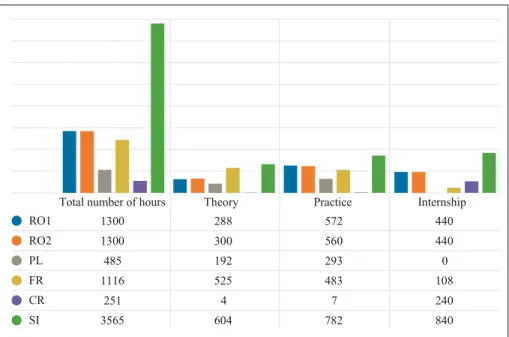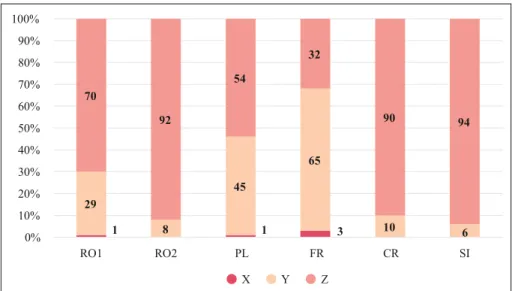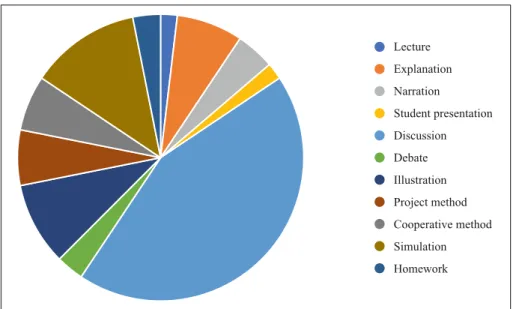DOI: 10.38146/BSZ.SPEC.2021.6.1
Ernő Krauzer
Didactic methods used in police training in some foreign countries
Abstract
In the publication, I present the didactic methods used in the training of deputy police officers, the amount of time spent on training, the number of students in the training, and the proportion of theory-practice. I will explain whether the different generations are taken into account during the training, and whether smart tools are used, as well as the availability and quality of personal and material conditions.
Keywords: training, education, didactics, policeman, school, theory, practice, internship, methods
Introduction
At the Doctoral School of Law Enforcement of the University of Public Service, I am conducting research on the development of the teaching methodology of police deputy training, during which I conducted a questionnaire survey in for- eign countries for the purpose of data collection (Krauzer, 2020). The goal of the data collection is to gain experience in the practice of police officer training abroad. It is important to emphasize that the data collection specifically covered the school-based, full-time police officer training. For the training of prospec- tive police officers who, after successfully completing school, perform service duties in the public order service branch, in uniform, in public places.
I carried out the questionnaire survey at the following foreign police school 1:
• ‘Septimiu Muresan’ Police School - Romania, Cluj-Napoca (RO1), 2004.
• Border Police Agents Training School - Romania, Oradea (RO2), 1992.
• Police School in Katowice - Poland, Katowice (PL), 1999.
• National Police school of SENS - France, Sens (FR), 1946.
• Police school ‘Josip Jovic’ - Croatia, Zagreb (HR), 2000.
• Police College - Slovenia, Ljubljana (SI), 1972.
Data on police training
The permanence of police training is shown by since when the training takes place at the educational institution, by the history of the given training, from which we can conclude the maturity of the training. We can really talk about training experiences if the given training has been carried out for several years - possibly for several decades - in an essentially unchanged structure. If a given training changes from year to year, we do not get real knowledge of whether changes are actually needed. Nowadays, change is common, which does not necessarily have professional reasons. In the case if police training appears on the training palette of a given country as an independent, state-recognized pro- fession, it must adapt to general changes in education and to those expectations.
This may have formal and substantive requirements. Schools providing police training must also adapt to the needs of their customers and the police, which does not always have a positive effect on training. Adaptation for schools is basically not a problem if they have time to run the training they started earlier and are given enough time to introduce new ones.
The data I have examined show that in France and Slovenia the roots of police training have a significant history, while in other countries the establishment of schools is between 16 and 28 years old, suggesting that experiential police training could only have developed more or less. It is clear that founding police schools in the former socialist countries, - with the exception of Croatia - took place in the years following the change of regime.
1 The abbreviation in parentheses after the name of the schools is the notation used hereinafter in the ar- ticle, and the year numbers represent the date of establishment of the schools.
Figure 1: Training length in months
Note: The author’s own editing.
The duration of police training is between 6 and 24 months in the countries surveyed. In general, the typical training period is 12 months, which suggests that one year of training is considered sufficient in the studied states. It is worth comparing this in the light of the fact that in Hungary the training of police of- ficers was 10 months from the 1980s to 1992, and then it became two years, ie 24 months (Kenedli, 2008). Nowadays – from the autumn of 2020 – in ad- dition to the two-year training, the 10-month training has been re-introduced in parallel. The two-year training can only be carried out at the Körmend Law Enforcement Technical School and the Miskolc Law Enforcement Technical School, while the 10-month training can be completed at the newly established Police Training Academy, at Adyliget and Szeged under of the Police Educa- tion and Training Center.
12 12
6
12 12
24
0 5 10 15 20 25 30
RO1 RO2 PL FR CR SI
Figure 2: Total number of training hours (theory-practice-professional practice) – (total number of hours, theory, practice, internship)
Note: The author’s own editing.
In Cluj-Napoca and Oradea, there is a minimal difference in police training, which suggests that the training of police officers takes place according to a central training program, on the basis of predetermined number of hours, in which the permitted deviation is minimal. The Slovenian police training shows an inter- esting picture, which includes 1339 lessons in which prospective police officers study independently. In Poland, due to its short duration, the training does not include internships with police forces. The proportion of theoretical and prac- tical lessons is basically 40–60%. It is important to point out that, - with the exception of Poland - internships with police forces appear everywhere, which is not the same as trainings in police schools. One cannot replace the other be- cause both have different roles in training. We can also approach this that it is expedient to send the participants to the internship if they already have the ap- propriate theoretical and practical knowledge. So, theory-practice-profession- al practice is a process based on each other, and all practical occupations have a theoretical basis.
Total number of hours Theory Practice Internship
RO1 1300 288 572 440
RO2 1300 300 560 440
PL 485 192 293 0
FR 1116 525 483 108
CR 251 4 7 240
SI 3565 604 782 840
Figure 3: Class size
Note: The author’s own editing.
Class sizes range from 21 to 30 for police training in Cluj-Napoca, Poland, and Croatia, from 11 to 20 for schools in Oradea and France, and between 21 and 25 for Slovenian schools. The significant difference between the two Romanian schools is striking. From the point of view of the effectiveness of the training, it is desirable for the class size to be as small as possible. In the case of large class sizes, it is a common practice to carry out the tasks divided into groups in some practical sessions. Of the six schools, class divisions are only in Ljublja- na, Slovenia. It is related to the class size whether the instructors can take into account the abilities and age specifics of the future police officers, and whether they use smart tools. The answers to these questions are given in Table 1.
Table 1: Considering abilities, age specifics, and using smart devices Country Consideration of
individual abilities
Consideration of age specifics (generations)
Using smart devices in %
1. Romania (Cluj-Napoca) No answer No Yes, 26–50
2. Romania (Oradea) Yes Yes Yes, 26–50
3. Poland Yes No No
4. France Yes Yes Yes, 0–25
5. Croatia No No No
6. Slovenia Yes No No
Note: The author’s own editing.
RO1 RO2 PL FR CR SI
30
20
30
20
30
25
0 5 10 15 20 25 30 35
There is an interesting difference between the two Romanian schools, and it can be stated that individual abilities can be taken into account in the training, but they are not yet prepared for generational differences. The regular use of smart tools is not yet a methodological requirement for everyday training. In my opinion, it is essential for effective and efficient education and training to take into account the abilities of students, to introduce individual, tailored de- velopment and to adapt to the learning habits of generations, and this is no dif- ferent in police training. Exploiting the possibilities offered by technical means is an essential condition for meeting the requirements of the age. In my point of view, the significant proliferation of smart devices in all areas of life points in the direction that they should not be banned, but consciously incorporated into training in the acquisition, application and incineration of new knowledge.
Figure 4: Generation classification of participants in training by age in %
Note: The author’s own editing.
1 1 3
29
8
45
65
10 6
70
92
54
32
90 94
0%
10%
20%
30%
40%
50%
60%
70%
80%
90%
100%
RO1 RO2 PL FR CR SI
X Y Z
Figure 5: Classification of participants according to their abilities in % (below average, average, above average)
Note: The author’s own editing.
There was no response from the French police school to the classification ac- cording to ability. Persons with above-average skills apply to Romanian police training, which suggests that high-quality training can be achieved. For the oth- er countries, people of average skills take part in the training. In my opinion, ensuring the replenishment of the police should not only consist of replenish- ing the quantity, but also issuing quality professionals from the police schools.
Professionals who are well prepared for the work and profession of the police are able to perform their tasks to a high standard, as a result of which the pro- fessional judgment of the police improves, and their social acceptance increas- es. I think it is important that police students who are admitted with different abilities do not only receive general training, in which the talented cannot de- velop further, nor does the catching up of the weaker ones take place. Great em- phasis should be placed on both categories so that the development of talented people is unbroken, and the weaker ones have a realistic chance of rising to at least the average level. This, in turn, requires the implementation of training that takes into account the abilities of the individuals and has a personalized development plan. Of course, this means a significant additional task for the instructors, because it is not enough to ‘just’ hold the lessons, but it is neces- sary to constantly monitor the development and abilities of the participants in the training. An attempt should be made to get the most out of everyone and to anticipate what police duties an individual is recommended to perform after
10 10
20
17
100
0
80 77
70 83
0
10 13
0%
10%
20%
30%
40%
50%
60%
70%
80%
90%
100%
RO1 RO2 PL FR CR SI
below average average above average
completing the training. It should be noted that a trained police officer is not suitable to perform all tasks either. The individual’s ability, readiness and per- sonality determine the ideal service task for him or her. For example, patrol or district commissioner work or team service activities require different people within the public order service branch.
Didactic methods applied in the training
The questionnaire survey asked which of the didactic methods listed in the lit- erature (Tigyiné-Pusztafalvi, 2015) are used by the institutions and in what percentage.
Figure 6: Didactic methods applied in the training in % (Cluj-Napoca) (lecture, explanation, narration, student presentation, discussion, debate, illustration, project method, cooperative method, simulation, homework)
Note: The author’s own editing.
In Cluj-Napoca, Romania, all didactic methods are used in police training, the first four places include:
1. Discussion 2. Simulation 3. Illustration 4. Explanation
Lecture Explanation Narration
Student presentation Discussion Debate Illustration Project method Cooperative method Simulation Homework
This sequence suggests that the traditional Prussian, frontal education model has been replaced by a more modern one, moving toward practice-oriented train- ing, highlighting the importance of trainees and hands-on activities embodied in simulation and illustration. I also looked for the answer to the question of how effectively the applied didactic methods appear in the training, but I did not receive an answer from the police school in Cluj-Napoca.
Figure 7: Didactic methods applied in the training in % (Oradea)
Note: The author’s own editing.
The Oradea Police School does not use a student presentation, which, in my opinion, strengthens the sense of responsibility and independence in addition to the deeper acquisition of professional knowledge, as it must be manifested in front of the peers and the instructor. At the same time, I do not think that this would be a mistake, because other didactic methods may include the develop- ment and awareness of the competencies described above. Regarding the didactic methods used, the school did not indicate a percentage of application. The fol- lowing response was received to the effectiveness of the didactic methods used:
1. Simulation: 100%
2. Illustration: 100%
3. Discussion: 90%
4. Explanation: 90%.
Lecture Explanation Narration
Student presentation Discussion Debate Illustration Project method Cooperative method Simulation Homework
From the efficiency data, we can conclude that, similarly to the school in Cluj-Na- poca, a practice-oriented educational model is used. In my opinion, this will make it much easier for police officers issued from the school to integrate into the various places of service, and it will also make it easier for police forces to work because they get trained police officers who do not have to be specially trained for basic professional tasks.
Figure 8: Didactic methods used in training in % (Katowice, Poland)
Note: The author’s own editing.
Among the general didactic methods, narration, student presentation, discus- sion, project method and cooperative method are not used in the police school in Katowice, Poland. Between the didactic methods applied, the order of strength is as follows:
1. Simulation 2. Illustration 3. Lecture 4. Homework
Lecture Explanation Narration
Student presentation Discussion Debate Illustration Project method Cooperative method Simulation Homework
Regarding the effectiveness of the didactic methods used, the following re- sponse was received:
1. Explanation: 80%
2. Lecture: 70%.
From the given data, it can be concluded that in addition to the traditional edu- cational model, a practice-oriented reinforcement also appears.
Figure 9: Didactic methods used in training in % (Sens, France)
Note: The author’s own editing.
At the police school of Sense in France, they do not apply from the didactic meth- ods the lecture, narration, and the project method. The didactic methods used were not classified, nor was a response received regarding their effectiveness.
Lecture Explanation Narration
Student presentation Discussion Debate Illustration Project method Cooperative method Simulation Homework
Figure 10: Didactic methods used in the training (Zagreb, Croatia)
Note: The author’s own editing.
All didactic methods are used in the police school in Zagreb, Croatia, but no answer was given regarding the percentage of their usage. The following order of strength was indicated for the effectiveness of the applied didactic methods:
1. Simulation: 95%
2. Illustration: 95%
3. Discussion: 75%
4. Debate: 75%.
Efficacy data suggest that a practice-oriented educational model is applied dur- ing the training.
Lecture Explanation Narration
Student presentation Discussion Debate Illustration Project method Cooperative method Simulation Homework
Figure 11: Didactic methods used in training (Ljubljana, Slovenia)
Note: The author’s own editing.
The Ljubljana Police School in Slovenia did not complete the didactic methods section of the questionnaire, but provided a textual answer stating that basically the following methods appear in the training:
1. Lecture 2. Explanation 3. Simulation
The type of didactic method is chosen by the instructor according to the content of the training curriculum. This means that the instructor has considerable free- dom in the transfer of knowledge. This can have a positive effect on the train- ing if the instructor chooses the enforced didactic method not only by taking into account the content of the curriculum to be acquired, but also the abilities of the participants in the training. Quality assurance includes the fact that the institution works well if the instructor’s freedom, the didactic method used is recorded, for example in a lesson plan prepared in advance by the instructor. So it is not about improvisation, but about using carefully constructed, conscious- ly chosen didactic methods.
The efficiency of the applied didactic methods is not measured, they do not have data, therefore no answer was received to this question.
Lecture Explanation Narration
Student presentation Discussion Debate Illustration Project method Cooperative method Simulation Homework
Availability of personal and material conditions during the training
In the questionnaire, I addressed whether schools have an adequate number and quality of instructors. If not, where does the shortage appears, at the theo- retical education or at the practical training? The answers are shown in Table 2.
Table 2: Personal conditions during the training Police
School
Is the number of instructors
sufficient? Where is a shortage?
Yes No Theoretical
education Practical training
RO1 X X X
RO2 X X
PL X X X
FR X
HR X X
SI X X
Note: The author’s own editing.
It is striking that, with the exception of the police school in France, there is a shortage of instructors everywhere, especially in terms of practical training.
Table 3: Preparedness of instructors Police School Preparedness of instructors
Below average Average Over average
RO1 X
RO2 X X
PL X
FR X
HR X X X
SI X
Note: The author’s own editing.
In the French and Slovenian police schools, all instructors are above average, in Poland they are all average, in Cluj-Napoca all are below average, and the oth- ers give a mixed picture. The conclusion from these data, is that further training of instructors is absolutely necessary.
Table 4: Availability of tools for education Police School Availability of tools for education
0–25% 26–50% 51–75% 76–100%
RO1 X
RO2 X
PL X
FR X
HR X
SI X
Note: The author’s own editing.
With the exception of the Croatian police school, all schools have the material conditions for effective education.
The administrative burden of training
Nowadays, thanks to the spread and rapid development of information tech- nology, there are many opportunities to replace the seemingly bureaucratic, repetitive administrative burdens with electronic means. This may apply both to training documentation - framework curricula (URL1), training programs, subject programs, syllabi, class diaries, certificates, module closures, etc. - and to those led by instructors - lesson plans, descriptions, individual devel- opment plans, etc. Part of the administration is carried out by the staff of the study departments, as well as by the class teachers and instructors. Adminis- trative activity in many cases takes a significant amount of time, which could also be spent on education. In the questionnaire, I also covered these, which I classified into three categories - small, medium, large - and how much IT sup- port was provided.
Figure 12: Administrative burden (small, medium, large)
Note: The author’s own editing.
The administrative burden is felt to be small in Oradea, high in Ljubljana and medium in the other police schools.
Figure 13: IT support for administrative burdens (paper-based, electronic)
Note: The author’s own editing.
RO1 RO2 PL FR CR SI
0 20 40 60 80 100 120
Small Medium Large
RO1 RO2 PL FR CR SI
Paper-based Electronic
The performance of administrative tasks is generally supported by the IT sys- tem, but this is not enough. We can be completely satisfied if all the processes can be carried out by means of IT or even at the place of education.
Acceptance of the training
In my opinion, its acceptance plays an important role in all training, especial- ly in the training of police officers, because they are considered public figures and exercise their rights over citizens. It is not enough to think that everything is fine, and we are doing our job well, but - also in the spirit of quality assur- ance - we need to ask for feedback. In the questionnaire I identified five areas – 1. government, 2. society, 3. clients, police, 4, instructors, 5. students in train- ing - and asked for a percentage answer. The following responses were received from the six police schools, illustrated in Figure 14.
Figure 14: Acceptance of police training in % (students, instructors, clients, society, government)
Note: The author’s own editing.
RO1 RO2 PL FR CR SI
0 20 40 60 80 100 120
Government Society Clients Instructors Students
No data were received from France and Slovenia on the acceptance of police training, and in Poland only from the students. In Romania and Croatia, based on the data sent, not only is police training acceptance, but the percentages in- dicate satisfaction.
Conclusions
Based on the answers of the six foreign schools dealing with the training of police officers, many similarities and differences can be established in resemblance with each other, as well as in comparison with the training in Hungary. Examining the results of the survey, we can see the strengths and weaknesses, from which, in my point of view, it is possible to build on and develop the Hungarian police training.
A very important additional task is to look at the international scene, as those ex- periences can point out directions for development. Fortunately, there are many examples in Hungary that the former four law schools in Adyliget, Körmend, Mi- skolc and Szeged regularly held international conferences with the participation of police schools in the partner countries to exchange experiences on the priority areas of police training. This tradition must be continued in the future.
References
Kenedli, T. (2008). The history of the Budapest Police Vocational High School and the police officer training (Part 1). National Security and Law Enforcement, 1(3), 60–71.
Krauzer, E. (2020). Questionnaire - Research on the development of the teaching methodology of police officer training. Nemzeti Közszolgálati Egyetem, Rendészettudományi Doktori Iskola.
Tigyiné-Pusztafalvi, H. (2015). Teaching methods and ways of organizing education chapter. In Bethlehem J. (Ed.), Healthcare methodology (pp. 33–48). Budapesti Műszaki és Gazdaságtu- dományi Egyetem, Tanárképző Központ.
Online links to this article
URL1: Vocational training framework curricula (From the 1st of Sept. 2013). https://www.nive.
hu/index.php?option=com_content&view=article&id=440
Reference of the article according to APA regulation
Krauzer, E. (2021). Didactic methods used in police training in some foreign countries. Belügyi Szemle, 69(SI6), 8-25. https://doi.org/10.38146/BSZ.SPEC.2021.6.1









